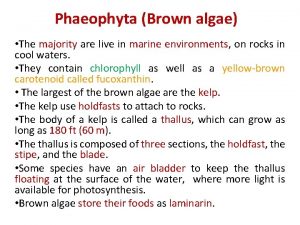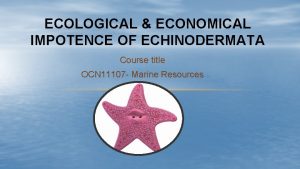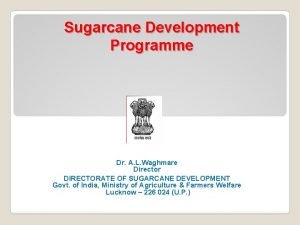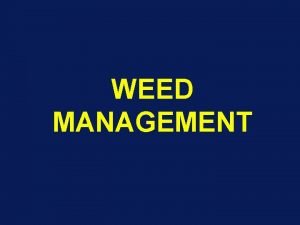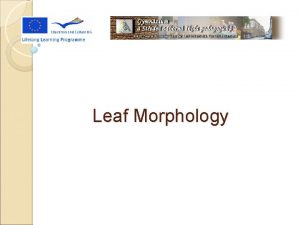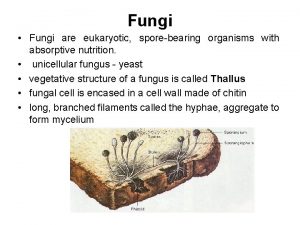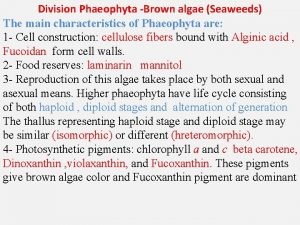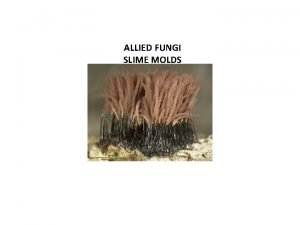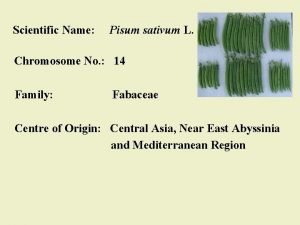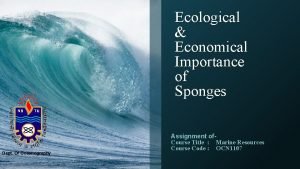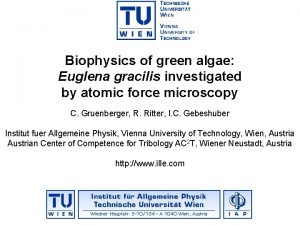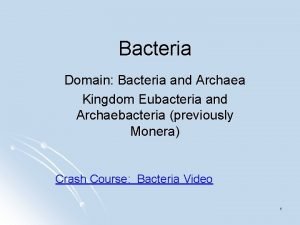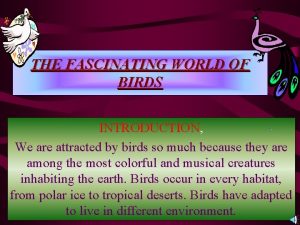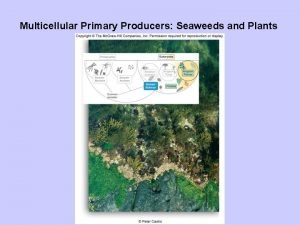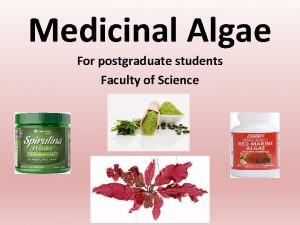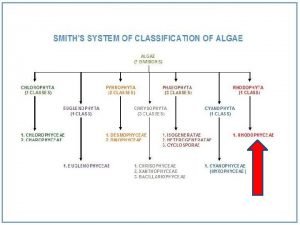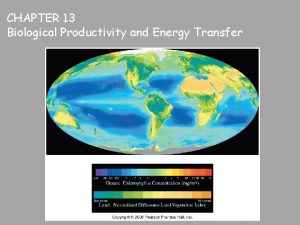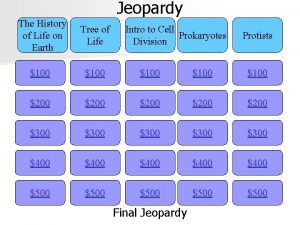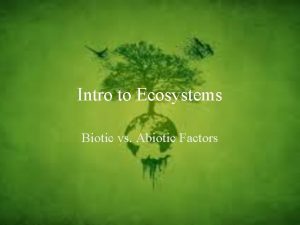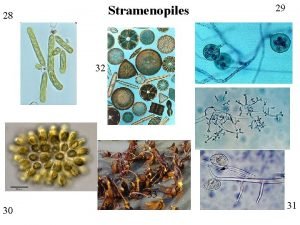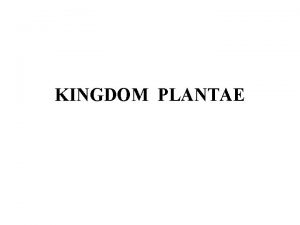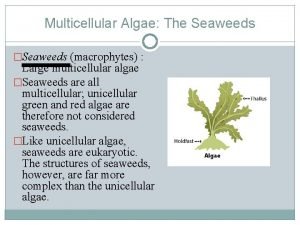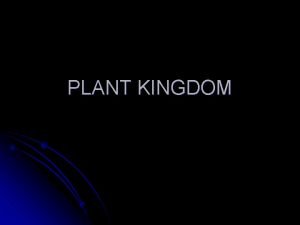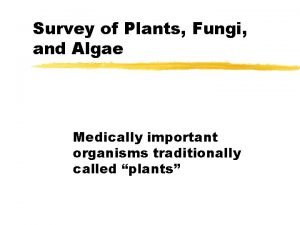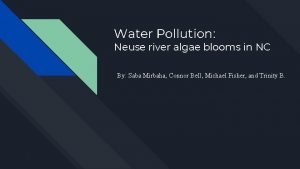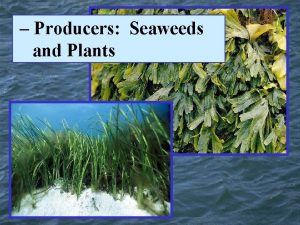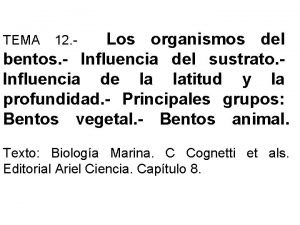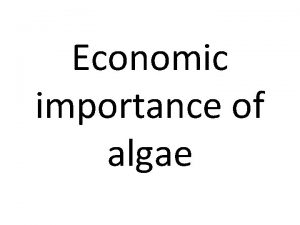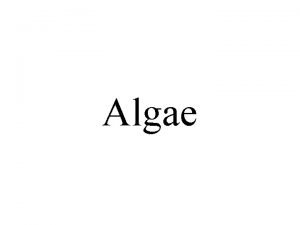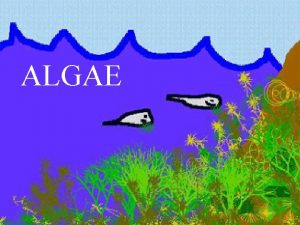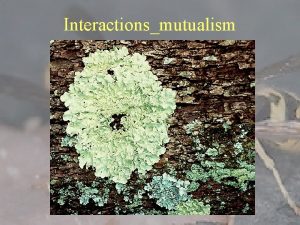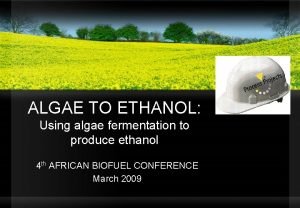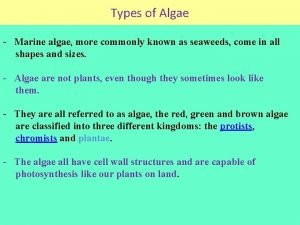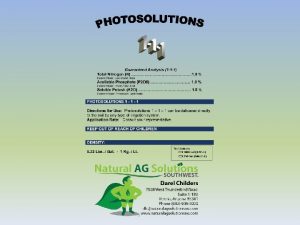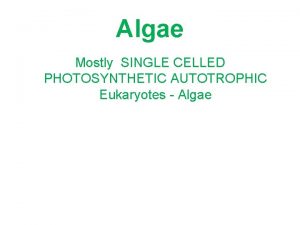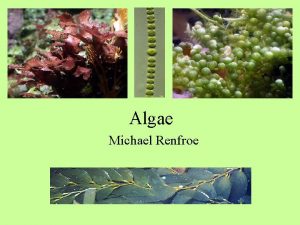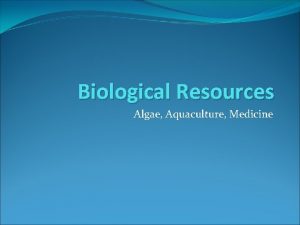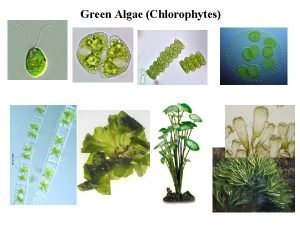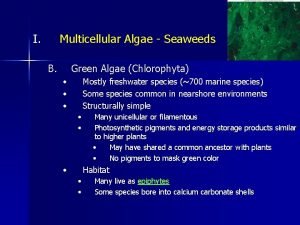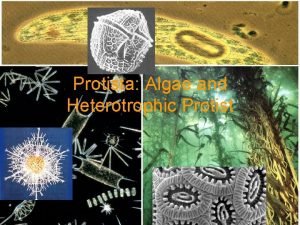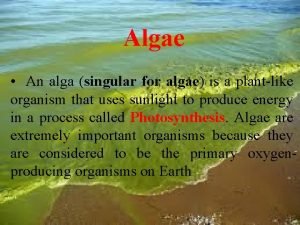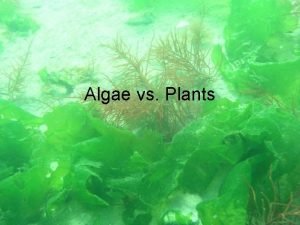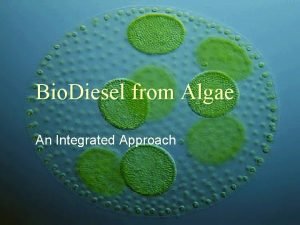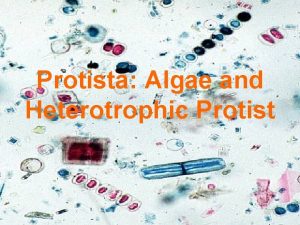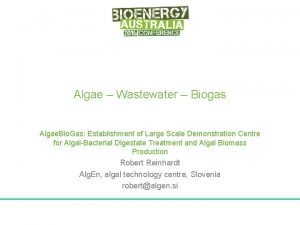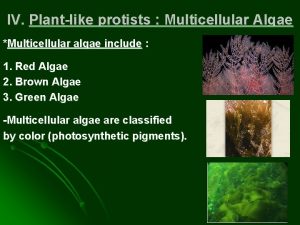Economic importance of algae Economic importance of Algae



















































- Slides: 51

Economic importance of algae



Economic importance of Algae Since from olden days Algae species are intimately connected with human beings as a source food, medicine and other uses. Algae are taking an active role in human beings. 1. Primary Producers: Algae are the main Oxygen producers in aquatic areas. They are also useful in decreasing water pollution by realizing Oxygen. 10% of photosynthesis is occurred by the algae in total photosynthesis quantity. With these activity algae forms 1. 6 -15. 5 x 10 to the power of 11 tones of carbonic material like food.

2. Algae as food: Algae species are used as food in several countries in several forms. Algae species have proteins, vitamins (A, B, C and E), lipids, and minerals. Laminaria species is the important edible seaweed in Japan and the food item ‘Kombu’ is prepared from it. ‘Aonori’ from Monostroma; ‘Asakusa Nori’ from Porphyra are prepared in different countries. Porphyra has 35% protein, 45% carbohydrates, Vitamins B and C and Niacin. Nostoc is used as food material in South America. 3. Algae as fodder for cattle: Rhodymenia palmate is used as food for sheeps in Narvey. Laminaria saccharina, Pelvitia, Ascophyllum, etc. species are used as food for cattles.

4. Algae as fertilizers: Blue-green algae are treated as bio-fertilizers from olden days. Nostoc, Oscillatoria, Scytonema, Spirulina, etc. are used as fertilizers to rice fields. All these algae are fixed the atmosphere Nitrogen in to ground. Cultivation of Spirulina is gaining importance as feed for fish, poultry and cattle. 5. Algae in Pisi culture: Sea algae are used as food for fishes. So they play an important role in Pisi culture. Some green-algae, Diatoms, some blue-green algae are used as food material to fishes. These are also making the water clean, by realizing Oxygen.

6. Algae in reclamation of alkaline or Usar soils: Our country has more number of alkaline soils or sterile soils. Blue-green algae like Nostoc, Oscillatoria, Scytonema, Spirulina are modified the soils in to fertile soils. Because they fixed Nitrogen in to soil. Nearly they fixed 400 K. g. of Nitrogen per year. Soil erosion is also reduced by these algae.

7. Algea in industry: Iodine industry is mainly depended upon algae. Algae belonging to Phaeophyceae, like Laminaria, Ecklonia, Eisenia, etc. are used in the industry to prepare Iodine in industries. Phyllophora is used to prepare Iodine in Russia. 8. Alginates: Alginates are the salts of alginic acid found in the cell wall of phaeophyceae. Alginates are extracted from Fucus, Laminaria, Macrocystis and Ecklonia. Alginates are used in the preparation of flame-proof fibrics, plastics, paints, gauze material in surgical dressing, soups, ice creams etc.

Agar-Agar: Agar-agar is a jelly like substance of great economic value. It is obtained from certain red algae like Gelidium, Graciliaria, and Gigartina. Agar is used as a culture medium for growing callus in tissue culture.

10. Carragheen or Carragheenin: It is extracted from cell walls of red algae like Chondrus and Gigartina. It is a polysaccharide esterfied with sulphate. It is used as emulsifier in pharmaceutical industry and also in textile, leather, cosmetics and brewing industries. 11. Diatomite: Diatoms deposits at marine and fresh water areas. They are rich with silica. It is called as diatomite. It is used in the preparation of Dynamite in olden days. But now it is used in different industries like glass, metal polishing, paints, tooth pasts, soups, etc.

12. Funori: It is a type of glue obtained from a red alga Gloipeltis furcata. It is used as an adhesive as well as sizing agent for paper and cloth. Chemically it is similar to agar-agar except that there is no sulphate ester group. 13. Minerals: The brown sea weeds popularly called as kelps yield potash, soda, and iodine. Some sea weeds are rich source of iron, zinc, copper, manganese and boron. Bromine is extracted from red algae such as Polysiphonia and Rhodymenia.

Antibiotics and Medicines: Antibiotic Chlorellin, obtained from Chlorella is effective against a number of pathogenic bacteria. Extracts from Cladophora, Lyngbya can kill pathogenic Pseudomonas and Mycobacterium. Laminaria is used as one of the modern tools for abortion. Seaweeds have beneficial effect on gall bladders, pancreas, kidneys, uterus and thyroid glands. 15. Role of Algae in Sewage Disposal: Some species like Chlamydomonas, Scenedesmus, Chlorella, Pondorhina, Euridina, etc are living in sewage water. They are mainly useful to clean the water by realizing Oxygen. They also modified the carbonate material in the water into N, P, K fertilizers

Algae as research material: In biological research algae are useful because of their rapid growth, brief life span and easy mode of cultivation. Chlorella, Scenedesmus and Anacystis are used in investigations in photosynthesis. Blue-green algae are used in studies on nitrogen fixation. Researches in Genetics and Cytology are carried out on Acetabularia. 17. Algae in Space: Chlorella and Synechococcus are finding application in space ships and nuclear submarines as oxygen regenerating and food and water recycling organisms.

Harmful aspects of Algae Some algae species like Microcystis, Lyngbya are develop water blooms in water areas. They secrete toxic materials into water. That they polluted the water. The algae, Cephaleuros virescence causes for red rust tea in tea plant. Some algae species are caused for some skin diseases. Dianophlagellate is caused for the death of fishes in water.

Because of their production of oxygen and their role in the food web, algae are normally beneficial to aquatic life. However, a bloom (a large and sudden growth in the population of phytoplankton) can cause the death of many fish. In most cases fish die because the decomposition of large amounts of algae depletes the oxygen in the water.

Phytoplankton that produce blooms called red tides produce toxins that kill fish directly. These toxins are also poisonous to humans; persons who eat shellfish contaminated with the toxins can become seriously ill. Most blooms occur in bodies of water that have been polluted with sewage or with runoff containing organic substances such as fertilizers.

Large forms of algae, primarily kelp, are a popular food in the Far East. They are dried and compressed into flat cakes. In Wales, a species of red alga is used to make a flat bread called laver bread. Algae are rich in vitamin C, thiamine, and potassium. They are used extensively as food for livestock and as fertilizers

Agar, or agar-agar, is a gelatinous substance derived from marine algae. Agar has many uses. It is used in laxatives, in materials on which dental impressions are made, in textile sizing, and in additives that thicken such foods as cheese, soup, and bakery products. Agar is also used as a gelling agent in cooking and, in laboratory work, as a medium in which bacteria are grown.

*Carrageenin, a jellylike substance derived from a marine alga commonly known as Irish moss, is also important in industry. Its most frequent use is in chocolate milk, where it holds the cocoa particles in suspension. • In addition, carrageenin is used in sauces, syrups, toothpastes, and cosmetics. Algin, derived from giant kelp, is also widely used in industry. The shells of dead diatoms make up diatomite, which has many commercial uses, including heat insulation and the filtration of liquids. • Certain species of single-celled algae have been tested for possible use in spacecraft as a source of oxygen and food for astronauts.


*Marine algae, as primary producers, are ecologically important, and economically have been used as food and medicines for centuries. *Today, various species of marine algae provide not only food but also produce extracts such as agar, carrageenans, and alginates. * These extracts are used in numerous food, pharmaceutical, cosmetic, and industrial applications.

Brown algae (Phaeophyta) includes Kelps (Macrocystis, Laminaria) and Ascophyllum, Fucus, and Sargassum. Alginic Acid (Alginate) is a colloidal product used for thickening, suspending, stabilizing, emulsifying, gel-forming, or film-forming, as required. About half of the alginate produced is used for making ice cream and other dairy products, the rest is used in other products, including shaving cream, rubber, or paint. In textiles, alginates are used to thicken fiber-reactive dye pastes, which facilitates sharpeness in printed lines and conserves dyes. Dentists use alginates to make dental impressions of teeth.

Applications using Alginates FOOD (Nondairy): Frozen foods, Pastry fillings, Syrups, Bakery icings, Relishes, Cooked/ instant puddings, Meringues, Chiffons, Dessert gels, Candies, Fruit juices, Jams & Jellies, Sauces and gravies, Pimiento strips, Salad dressings FOOD (Dairy): Whipped toppings, Milk shakes, Cheeses, Flans and custards, Instant breakfasts, Ice Cream INDUSTRIAL: Paper sizing / coatings, Adhesives, Textile printing / dyeing Air freshener gels, Explosives, Boiler compounds, Polishes Antifoaming agents, Ceramics, Welding rods, Cleaners, Castings and impressions, Enzyme immobilization MEDICAL & PHARMACEUTICAL: Baulking agents, Capsules and tablets, Lotions and creams, Ulcer products

Red algae (Rhodophyta) Carrageenan is made from Gigartina stellata, Chondrus crispus and Eucheuma. Carrageenan (carrageenin, carragheen) is similar to agar, but requires higher concentrations to form gels. Carrageenan is used for stabilizing chocolate, milk, egg nog, ice cream, sherbets, instant puddings, frostings, creamed soups, etc. Red algae (Rhodophyta) Agar is made from Gelidium, Gracilaria, Pterocladia and Ahnfeltia. Agar is another colloidal agent used for thickening, suspending, and stabilizing. However, it is best noted for its unique ability to form thermally reversible gels at low temperatures.

*The greatest use of agar is in association with food preparation and in the pharmaceutical industry (as a laxative, or as an inert carrier for drug products where slow release of the drug is required). *Agar is used in bacteriology and mycology as a stiffening agent in growth media. *Agar is used as a stabilizer for emulsions, and as a constituent of cosmetic skin preparations, ointments, and lotions.

*It is used in photographic film, shoe polish, dental impression molds, shaving soaps, hand lotions, and in the tanning industry. *In food, agar is used as a substitute for gelatin, as an antidrying agent in breads and pastry, and also for gelling and thickening purposes. *It is used in the manufacture of processed cheese, mayonnaise, puddings, creams, and jellies and in the manufacture of

Applications using Red Algae Carrageenan FOOD (Nondairy): Frozen foods, Dessert gels, Pastry fillings Fruit juices, Syrups, Jams & Jellies, Bakery icings, Sauces and gravies, Relishes, Pimiento strips, Cooked/ instant puddings, Salad dressings, Chiffons FOOD (Dairy): Whipped toppings, Milk shakes, Skim milk, Evaporated milk, Chocolate milk, Cheeses, Cottage cheese, Infant formulas, Flans and custards, Yogurt, Instant breakfasts, Ice cream INDUSTRIAL: Air freshener gels, Tertiary oil treatment, Cleaners, Enzyme immobilization, Electrophoretic media, Chromatographic media

MEDICAL & PHARMACEUTICAL: Laxatives, Baulking agents, Capsules and tablets, Lotions and creams, Shampoos, Ulcer products, Toothpastes Agar. FOOD (Nondairy): Frozen foods, Dessert gels, Bakery icings, Candies, Meringues, Fruit juices FOOD (Dairy): Cheeses, Yogurt INDUSTRIAL: Paper sizing / coatings, Microtomy media, Adhesives, Electrophoretic media, Textile printing / dyeing, Chromatographic media, Castings and impressions, Conductivity bridges MEDICAL & PHARMACEUTICAL: Laxatives, Capsules and tablets, Baulking agents, Suppositories, Radiology suspending agents, Anticoagulants

Industrial and other uses Fertilizer / soil amendments Miscellaneous species of Kelps (Brown algae), e. g. Laminaria, Macrocystis Filters / Rubbing compounds (polish) / Pest control (fleas) Diatoms in the form of Diatomaceous earth (diatomite) Sewage treatment to remove inorganic nutrients and toxins Unicellular freshwater Chlorophyta and other micro- and macroalgae.

Algae as the entrée Kombu, nori and wakame (Japan) Kombu = Laminaria Nori = Porphyra Wakame = Undaria stipes and blades Hai dai - (China) Laminaria Limu (Hawaii) - [Miscellaneous algal species] Limu kohu = Asparagopsis taxiformis Limu wawaeiole = Codium Limu huluwaena = Grateloupia filicina Limu palaha = Ulva Dulse (Scotland); Dillisk - (Ireland); Sol - (Iceland) Rhodymenia palmata Irish moss or Carraghean (Europe) Chondrus crispus Nori or Amanori (Japan); Zicai (China) Porphyra

1. Ulva lactuca (Green algae). U. lactuca (sea lettuce) has thin sheet-like fronds consisting of two layers of cells. It is a cosmopolitan species with a global distribution and growth rates up to 30% per day. It often is the cause of “green tides” in coastal areas with high nutrient loads. This species is utilized for human consumption and compost.

*The largest production yield of up to 74 dry ton per hectare has been demonstrated in the US Aquatic Species Programme. *Research has documented a methane yield from U. Lactuca of between 77 -560 ml per g volatile solids (VS). *This is equivalent to the yield from cattle manure and land based energy crops, such as grass-clover. *Direct combustion of U. Lactuca biomass is problematic due to a high ash content and a high content of alkali metals in the ash.

3. Enteromorpha sp. Ulva sp. (Green algae). This alga has short and slim delicate sheet or tube-like fronds. It has a global distribution and is used for human food in Asia, where it is harvested to prepare “aonori”. Enteromorpha is also sold as “seaweed meal” for feed and fertiliser. Yields of up to 28 dry g per m 2 per day are reported. This species has successfully been converted to bio-oil by hydrothermal liquefaction.

4. Gracilaria sp. (Red algae). Gracilaria sp. is typically branched and forms up to 60 cm long “bushes”. It is found in warm and temperate waters, and is spreading rapidly as an invasive species in northern temperate regions. Gracilaria sp. is notable for its economic importance due to its high content of agar, but is also used as a food for humans and various species of shellfish. Various species within the genus are cultivated in the developing world, including Asia, South America, Africa and Oceania. Annual production yield is reported to be up to 127 dry ton per hectare. Methane yields of 83 -540 ml per g VS are demonstrated.

Algae are the major source of the oxygen needed by aquatic animal life. Single-celled algae known as phytoplankton provide the food for larger organisms that, in turn, provide food for yet larger organisms. The interrelationship of these organisms is part of what is called the food web.

A Giant Kelp

Brown algae have many importances in the economic and environmental world. *The largest brown algae, kelp, are the most important in the ecosystem. They are used as food for herbivorous fish and shellfish. *One animal that especially likes brown algae is the sea urchin.

*They are very abundant in the kelp fields of the Pacific and can destroy entire forests in a very short time if there are too many urchins. *Kelp also provides a home for sea otters and starfish which eat the many urchins and create a more balanced ecosystem in that area. *Brown algae, along with green algae, are said to be responsible for producing as much as 60% of the food generated on a coral reef.

Brown algae are not only important to the environment but also in the human world. *We use the seaweeds commercially for food, cosmetics, pharmaceuticals and in the sciences. * The most important part of brown algae is algin, a starch-like chemical that is found in the cell walls of kelp.

*It is used as a stabilizer and emulsifier in making dairy products, prevents frosting and pies from drying out in the baking industry, a thickener in pharmaceutical and chemical and manufacturing industries, such as making toothpaste, shampoo, and a myriad of other products, used in making rubber products, paper, paints, and cosmetics, and it thickens printing paste which makes sharper print in the textile industry.

A kelp harvester and a ship filled with kelp!!!

Some brown algae product

It is also used as a fertilizer for farmers, as wound dressing in hospitals, used to reduce the acidity of soils in Europe, and can use methane they produce after fermenting for fuel. The last, and very important, reason they are useful is in food. They are used as an additive in many foods but also can be eaten. They can add flavor, color, and texture to soups, casseroles and many other dishes.

Is Algae the Biofuel of the Future? The tiny plants could provide renewable oil but industry wants a helping hand from government. There are some signs that the algaebased fuel industry might be ready to bloom.

Algae-based fuel producers use sunlight, water and carbon dioxide to convert carbon dioxide into sugar, which the algae metabolize into lipids, or oil. The industry says it can do so using non-potable water and without converting more forests into farm fields – thus addressing major criticisms of corn- and soy-based biofuels. GREEN POWER: Is slimy algae the key to a green energy future?

Algae : An Oil Crop of Future

Algae as Oil bearing plant : Micro-algae are single celled microscopic organisms which, like plants, use photosynthesis to convert the sun’s energy into chemical energy. *Micro-algae can be grown in large bioreactors that provide the algae with all the needs to maximize growth and oil production.

*Micro-algae are much more efficient converters of solar energy than any known plant, because they grow in suspension where they have unlimited access to water and more efficient access to CO 2 and dissolved nutrients. *The total oil content in algae can be up to 70% of their dry weight. *Micro-algae are capable of producing more than 30 times the amount of oil (per year per unit area of land) when compared to oil seed crops.

Some algae can grow in saline water. It is worth exploring the possible economic production of oils from algae using saline ground water in the growing ponds. Once the water becomes too salty for the algae to grow, it could be drained to evaporation ponds to recover the salts for use by the chemical industry

*Micro-algae are the fastest growing photosynthesizing organisms. They can complete an entire growing cycle every few days. *Upto 120 tons of oil/hectare/year can be produced from algae. *Algae production can be increased by increasing the carbon dioxide concentration in the water.

One of the problems with growing algae in any kind of pond is that only in the top 6 mm or so of the water does the algae receive enough solar radiation. So the ability of a pond to grow algae is limited by its surface area, not by its volume.
 Example of phaeophyta
Example of phaeophyta Green algae economic importance
Green algae economic importance Economic growth vs economic development
Economic growth vs economic development What is economic growth and development
What is economic growth and development Economics unit 1 lesson 2 difficult choices
Economics unit 1 lesson 2 difficult choices Economic importance of ocean
Economic importance of ocean Economic factors definition
Economic factors definition Importance of fungi
Importance of fungi Echinodermata
Echinodermata Branches of agricultural economics
Branches of agricultural economics Economic importance of sugarcane
Economic importance of sugarcane Kars bread
Kars bread Economic importance of weeds
Economic importance of weeds Parts of leaf
Parts of leaf 5 characteristics of protozoa
5 characteristics of protozoa Parenchymatous algae
Parenchymatous algae Cryptostomate
Cryptostomate Importance of economic growth
Importance of economic growth Allied fungi general characteristics
Allied fungi general characteristics Difference between field pea and garden pea
Difference between field pea and garden pea Groundnut economic importance
Groundnut economic importance Fungi diagram
Fungi diagram Economic importance of porifera
Economic importance of porifera Economic importance of euglena
Economic importance of euglena Www.assignmentpoint.com
Www.assignmentpoint.com Portuguese man of war habitat
Portuguese man of war habitat Economic importance of pinus
Economic importance of pinus Slime molds characteristics
Slime molds characteristics Importance of fungi in medicine
Importance of fungi in medicine Economic importance of rubber
Economic importance of rubber Archaebacteria facts
Archaebacteria facts Economic important of birds
Economic important of birds Peristome in bryophytes
Peristome in bryophytes Algae vs seaweed
Algae vs seaweed Medicinal algae
Medicinal algae Pencemaran eutrofikasi
Pencemaran eutrofikasi Red algae is oogamous
Red algae is oogamous Biological productivity examples
Biological productivity examples Are algae eukaryotic or prokaryotic
Are algae eukaryotic or prokaryotic Biotic and abiotic list
Biotic and abiotic list Rhizoids in algae
Rhizoids in algae Araphic
Araphic Ciri-ciri chlorella
Ciri-ciri chlorella Section 22-1 introduction to plants answer key
Section 22-1 introduction to plants answer key Algae classification
Algae classification Multicellular seaweed
Multicellular seaweed Algae are chlorophyll bearing
Algae are chlorophyll bearing Cyanbacteria
Cyanbacteria Brainpop algae
Brainpop algae Algin brown algae
Algin brown algae Coralline algae
Coralline algae Chlorella algae
Chlorella algae
